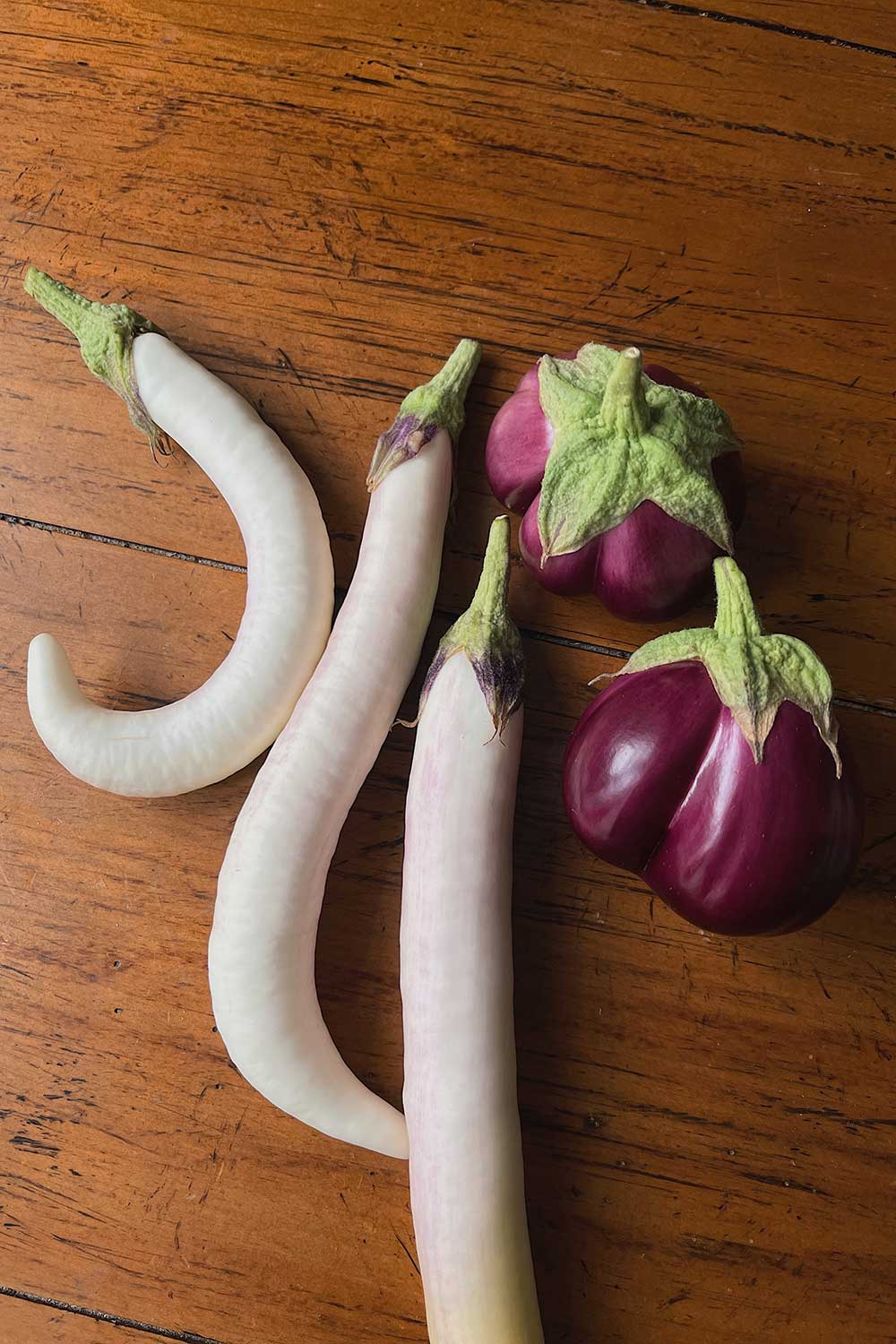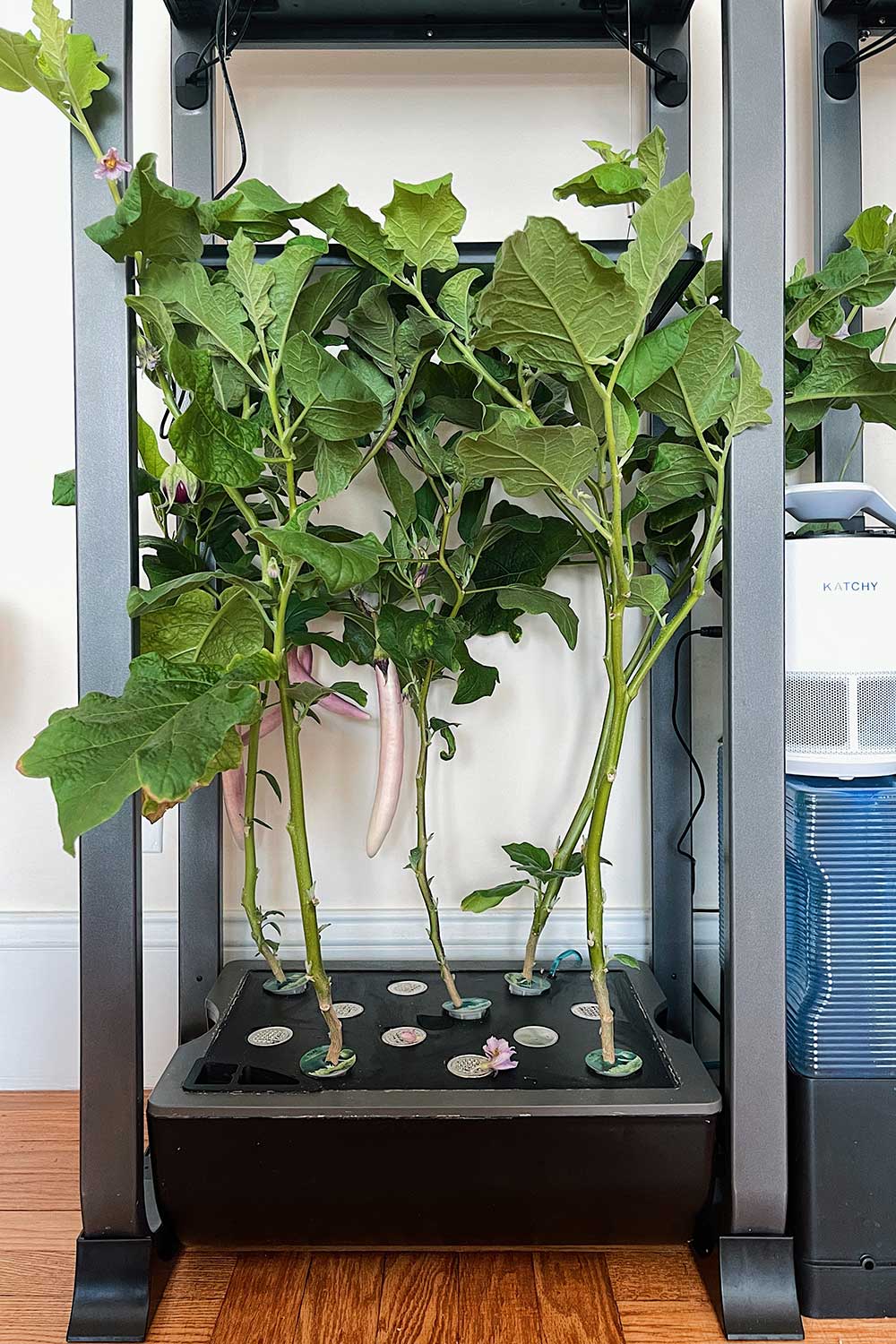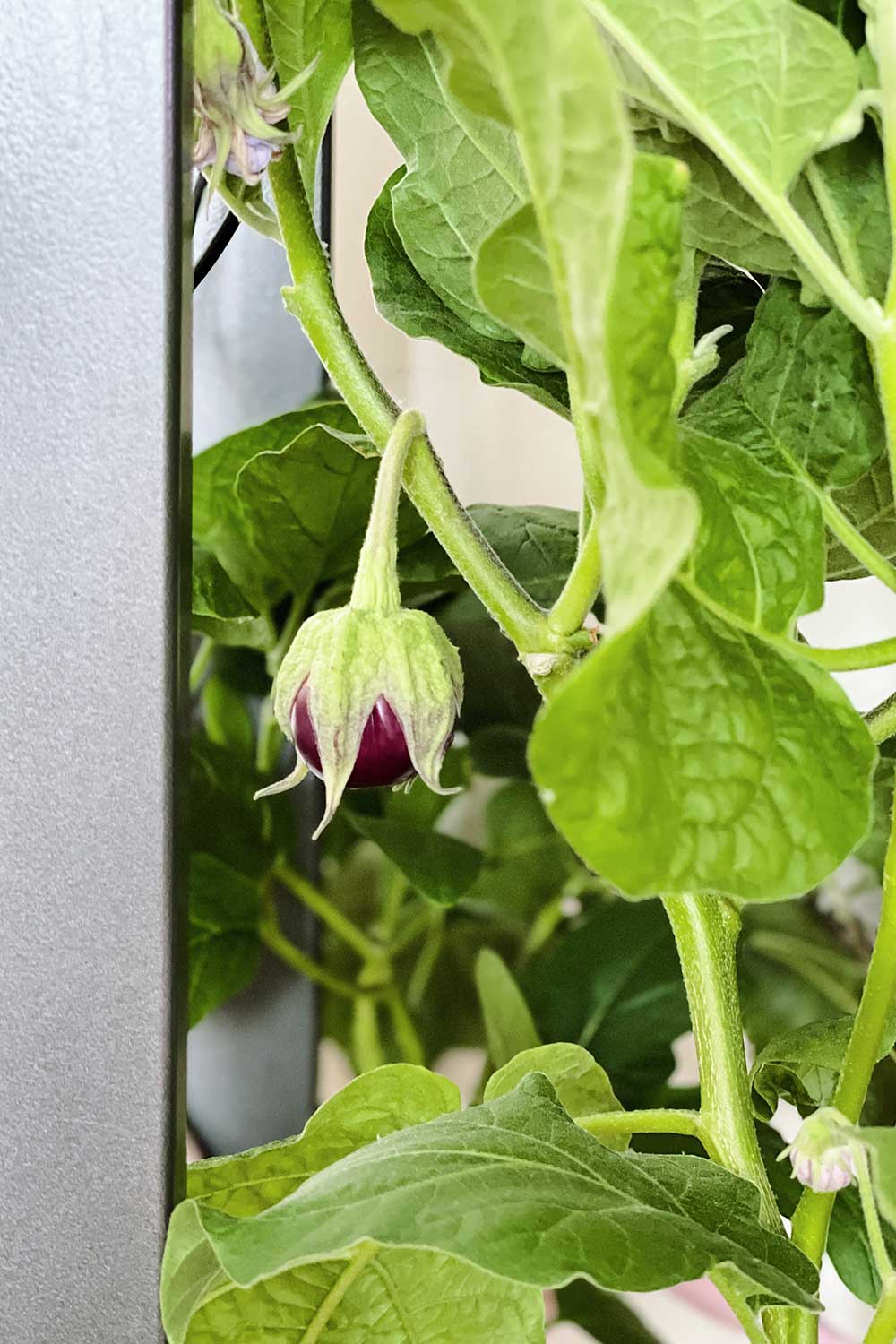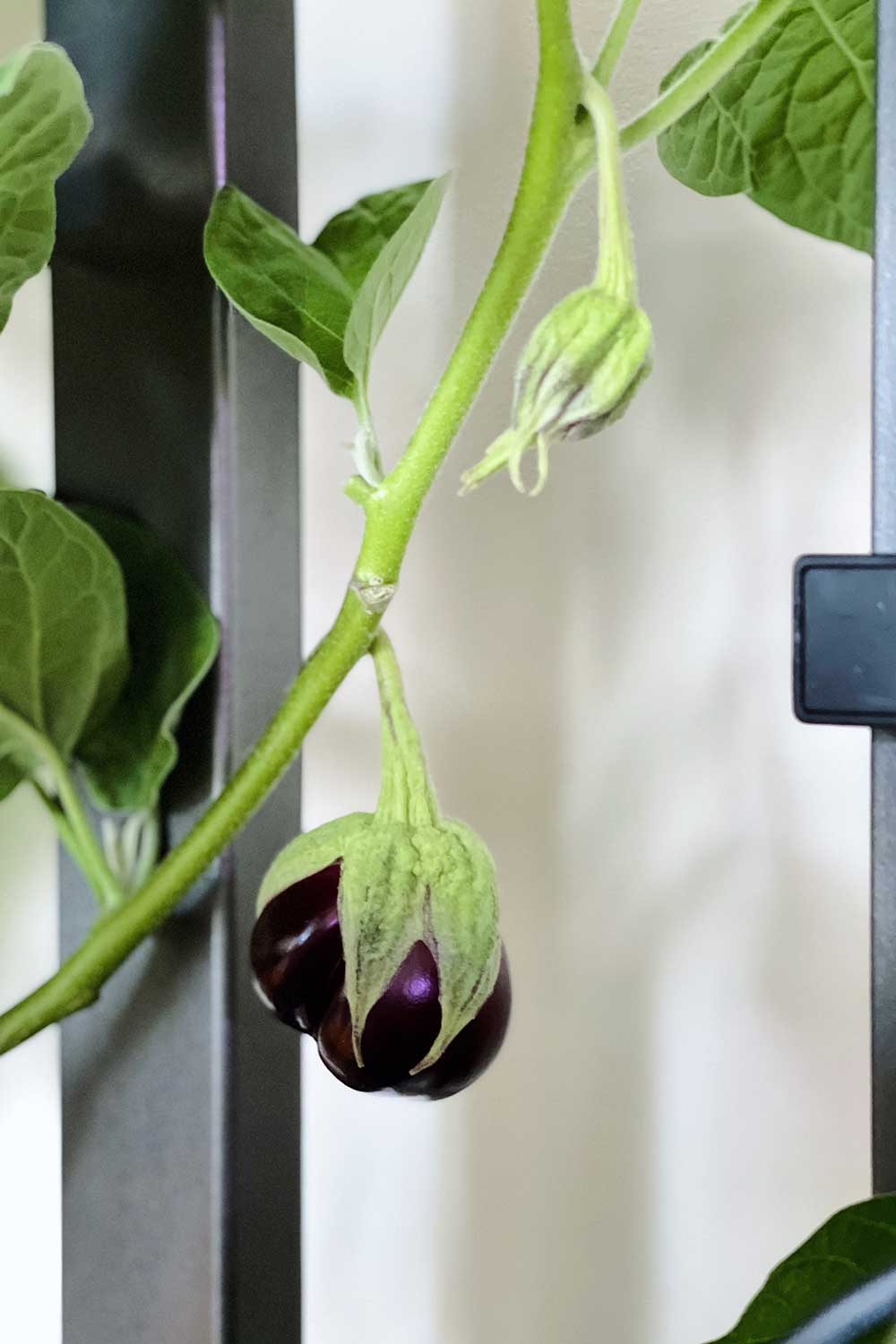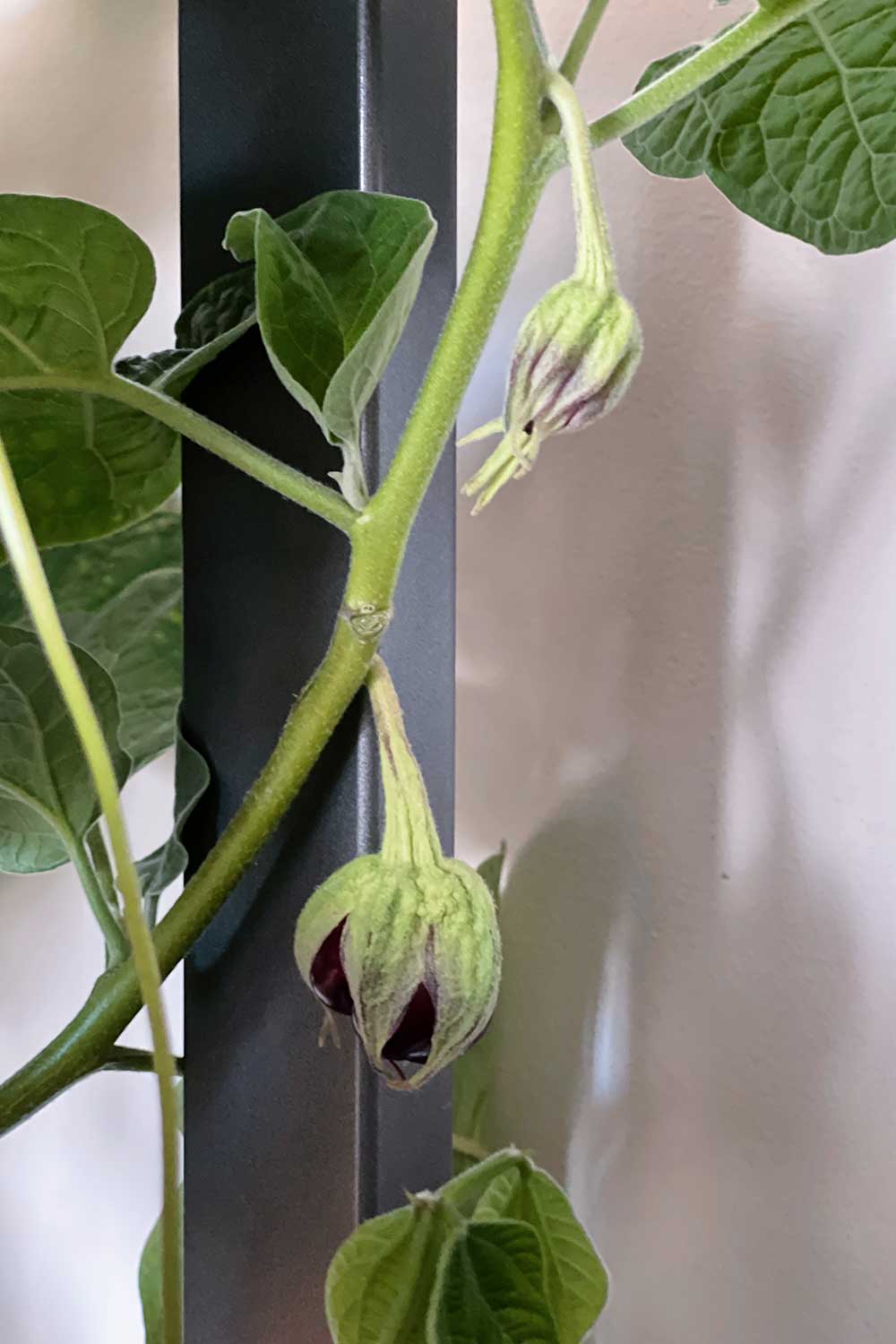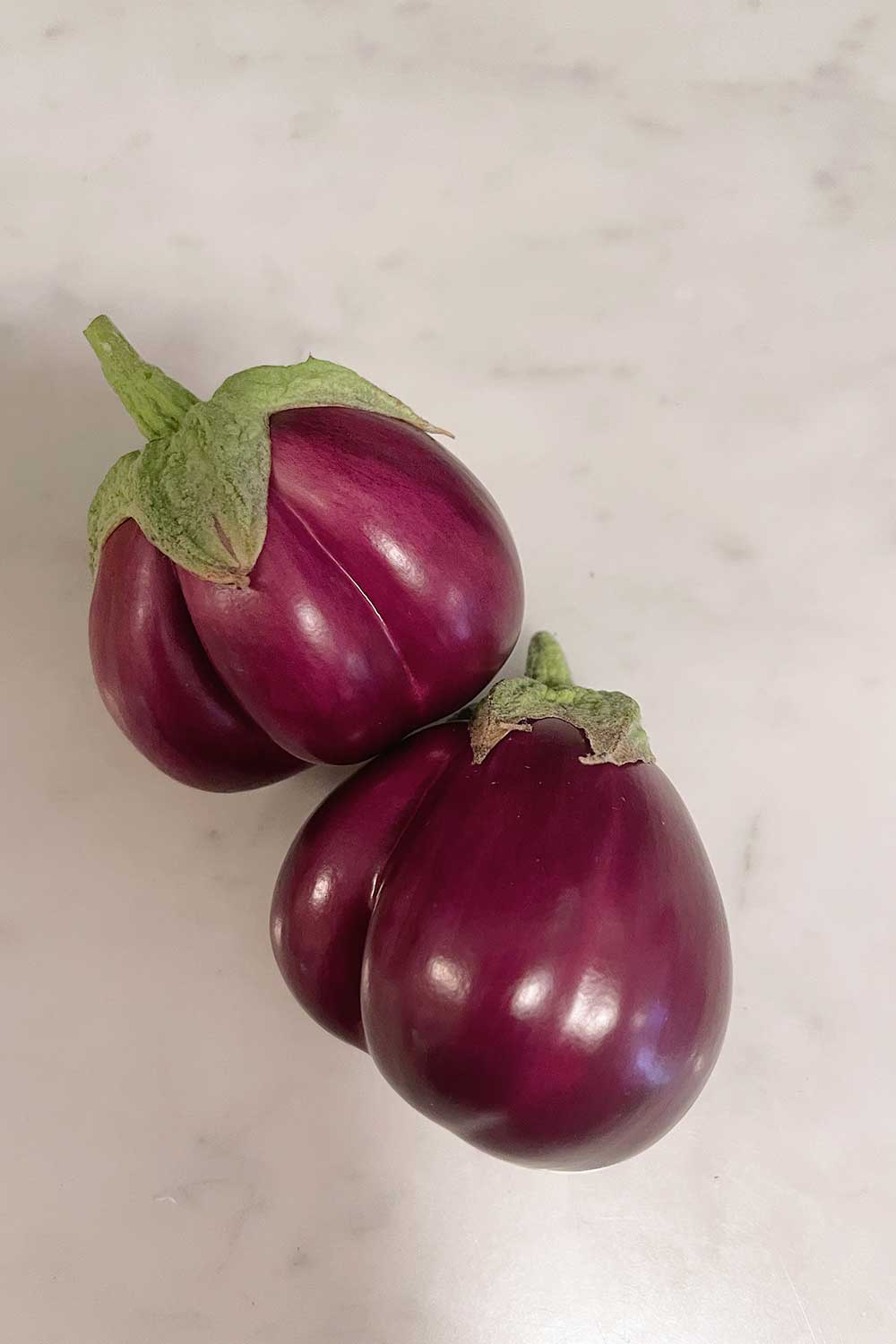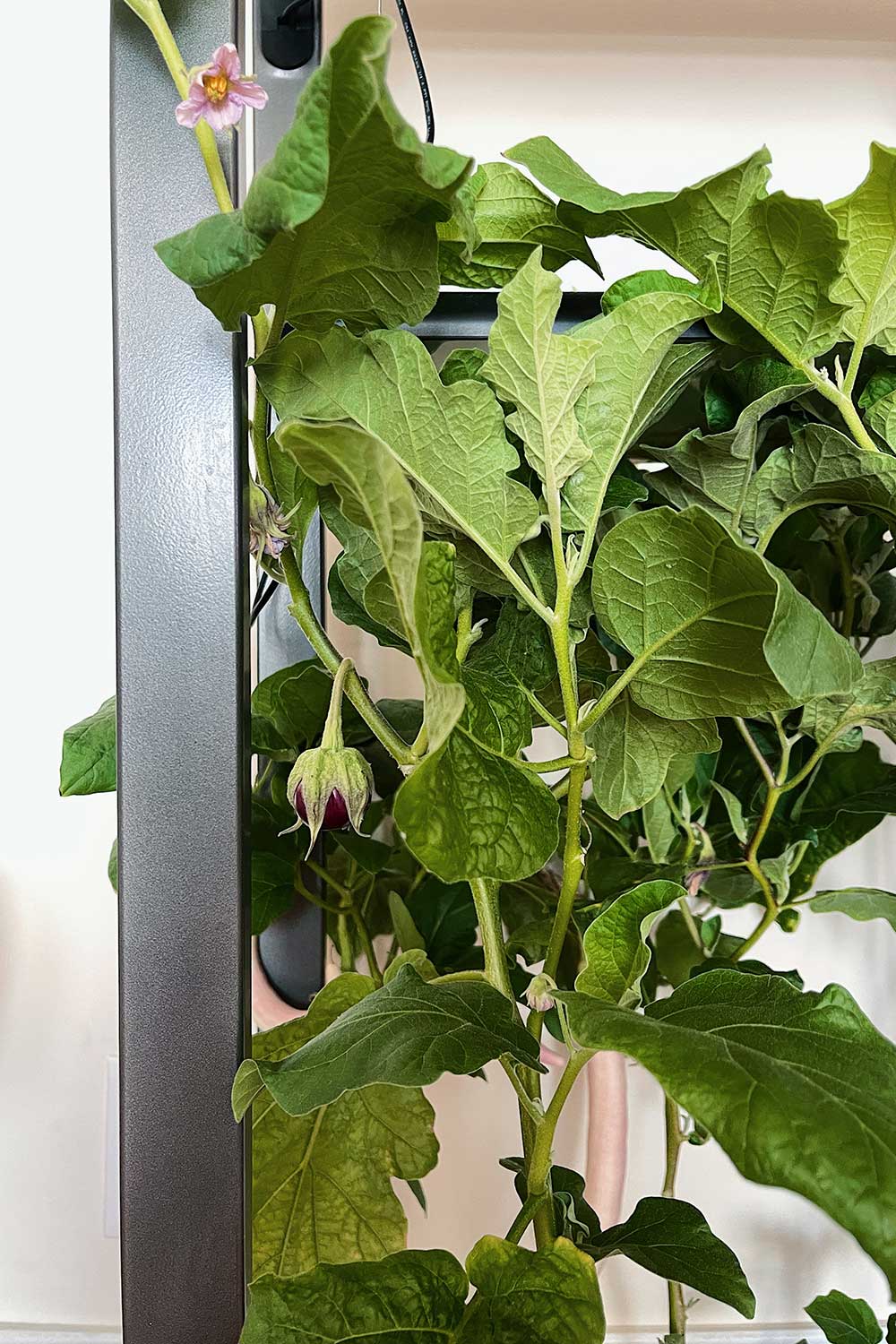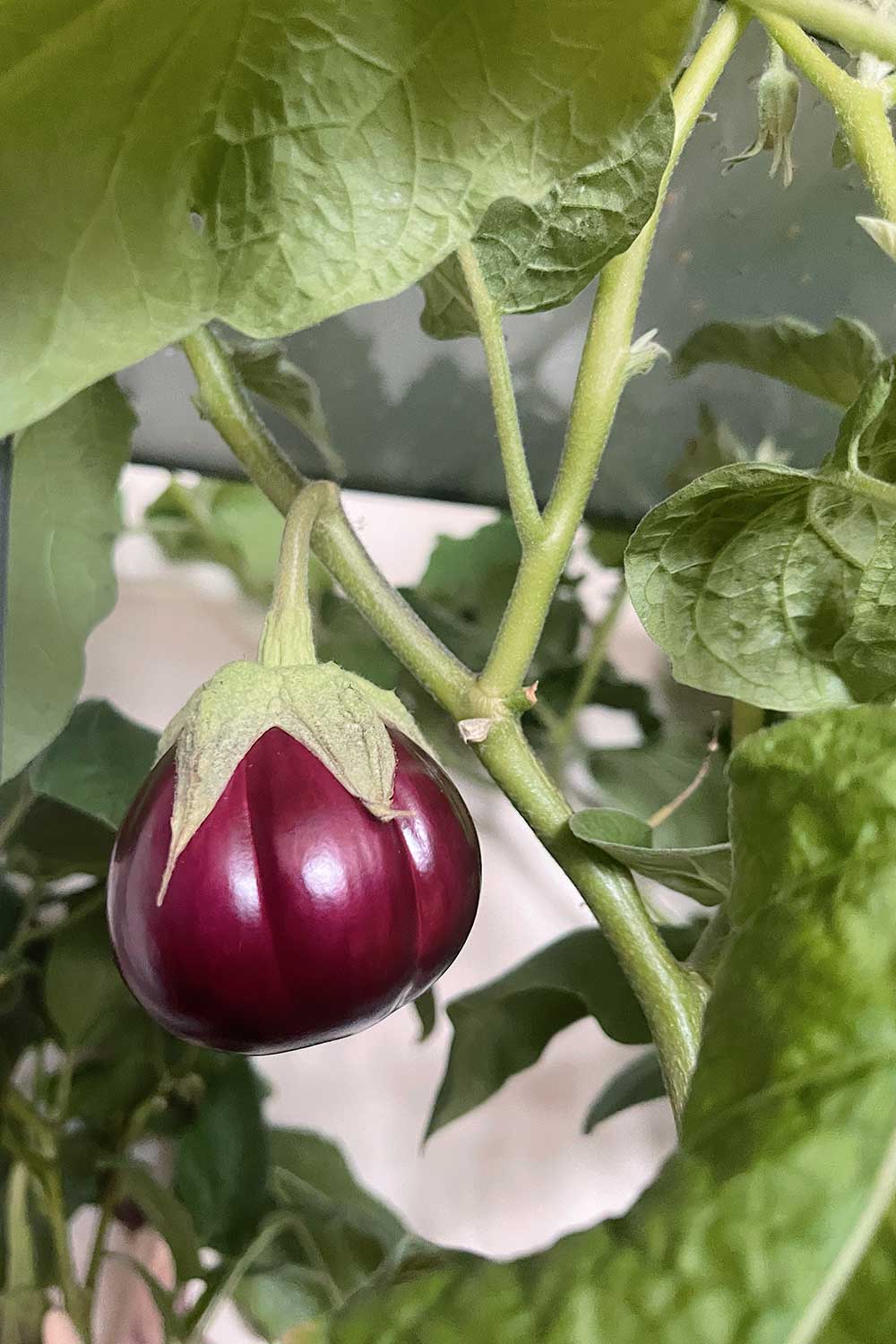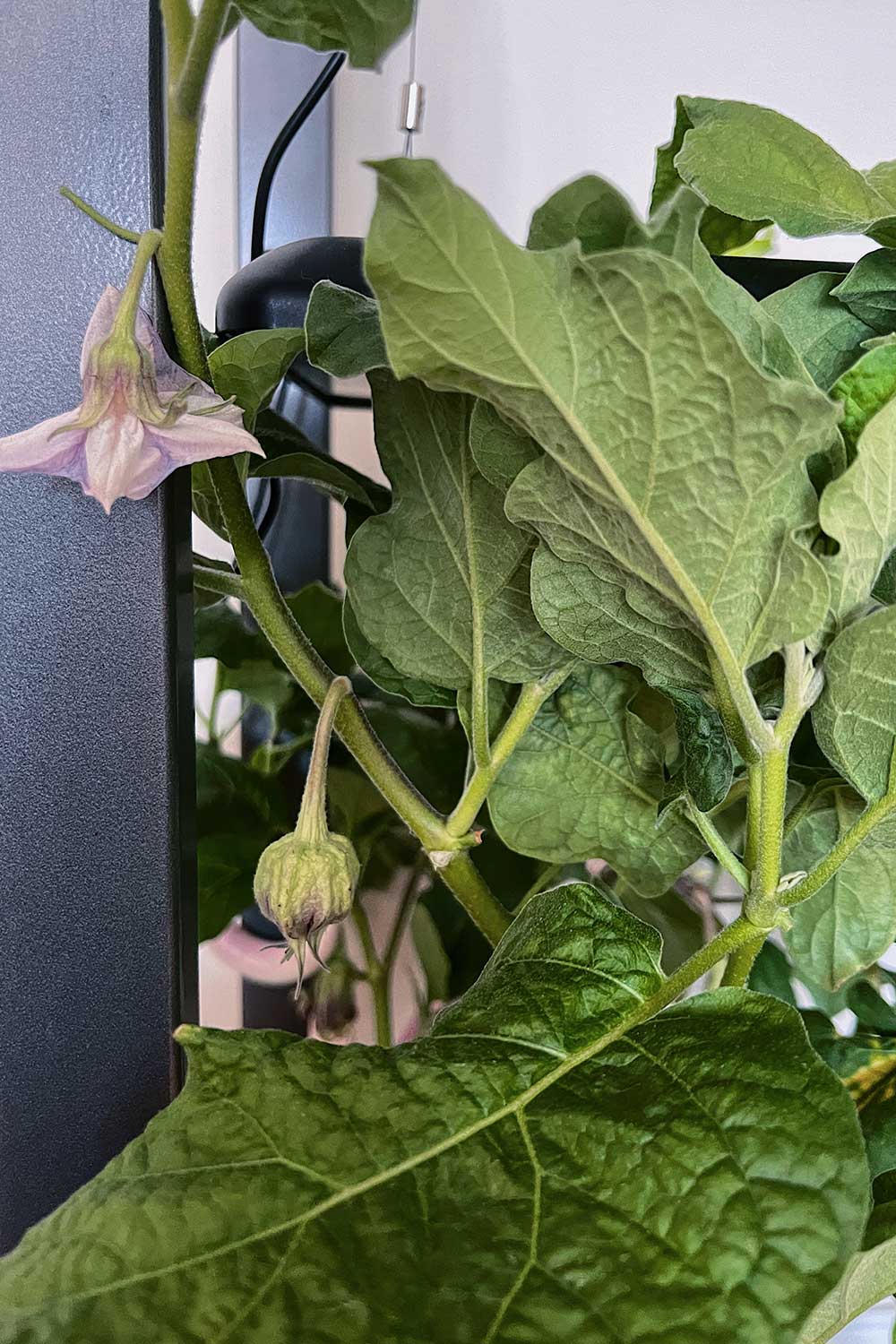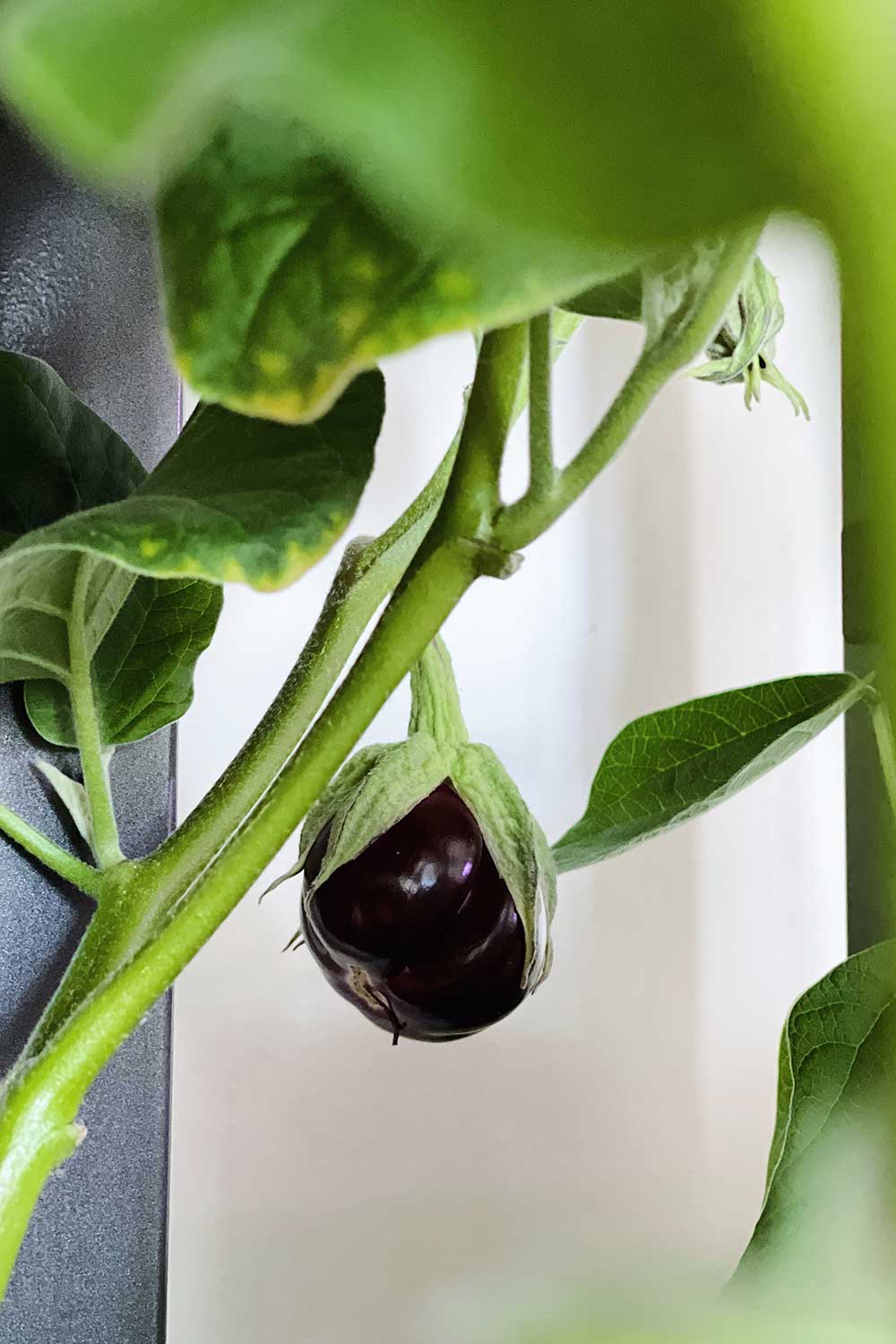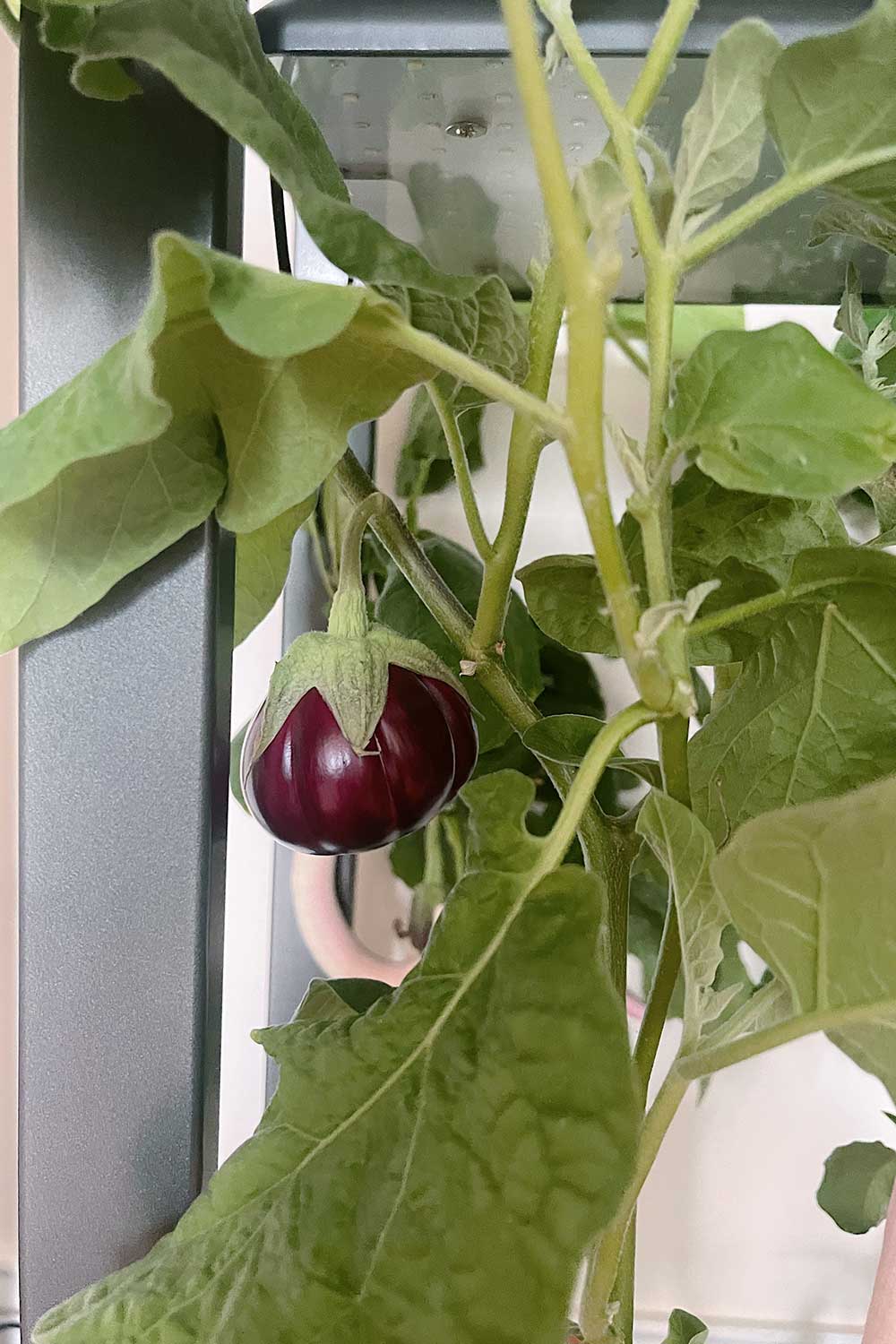Thai eggplants are some of the prettiest fruits – they look like mini purple pumpkins! These round, small eggplants are not only unique to look at but incredibly tasty.
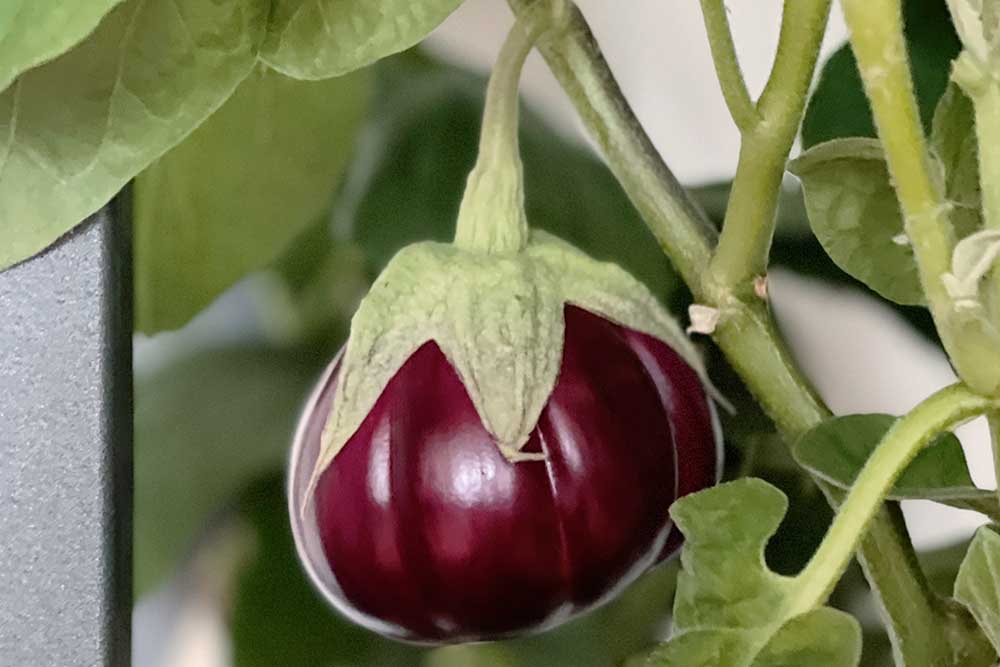
Thai Ribbed Eggplant
When I saw these Thai ribbed eggplants in a seed catalogue, I had to try growing them.
They’re one of the prettiest fruits I’ve ever seen – deep purple, glossy and plump.
They actually kind of look like purple pumpkins!
I impulsively bought a ton of Asian eggplant seeds, despite the fact that I never really liked eating eggplant.
But I was really pleasantly surprised.
Asian eggplants tend to be smaller than the American and Italian varieties I was used to.
And they taste quite different – thin skinned, sweet with tender flesh.
If you’re like me and never really liked regular eggplant, don’t write off the entire category – give Asian eggplants a try!
Eggplants are part of the nightshade family (along with tomatoes, peppers and potatoes) so they love sun and heat.
These are the quintessential summer crop – they can’t survive a frost.
Compared to tomatoes and peppers, I found eggplants very easy to grow.
These Thai ribbed varieties produce compact plants about 3 to 4 feet tall. They’re easy to grow and can be planted indoors or outdoors, as well as grown hydroponically!
Here’s everything I’ve learned about growing Thai ribbed eggplants.
Thai Eggplants
Eggplants are believed to have originated in India.
Their name came from Europeans who traveled to the East and saw white egg-shaped orbs growing in the ground.
Different varieties of eggplants were shared from India along trade routes throughout Asia and Europe.
Each region began to cultivate their own local hybrids, with most varieties domesticated to produce larger oblong fruits.
Thai eggplants look similar to the original Indian eggplant – small and circular, like little golf balls.
Types of Thai Eggplants
There’s tons of Thai eggplant varieties. Most are small and round, in shades of white or green.
Some of the most popular Thai eggplant varieties include:
- Thai round eggplants
- Thai white eggplants
- Thai purple eggplants
- Thai green eggplants
- Petch Siam eggplant
- Tiger hybrid eggplant
- Green doll eggplant
- Kermit hybrid eggplant
- Thai ribbed eggplant
Thai Eggplant
The Thai ribbed eggplant is a more unique variety.
It has deeply ribbed sections, that make it kind of look like a pumpkin! Most Thai ribbed eggplants are white, but you can also find purple varieties.
Apparently Thomas Jefferson liked the look of these so much that they were grown in his Monticello kitchen garden.
They have a rich eggplant flavor with skin of about medium thickness (in between Japanese or Chinese eggplants but not as thick as American eggplants).
I couldn’t get over how cute they looked!
The deep flutes really make them look like pumpkins. Almost too cute to eat!
If you’re looking to buy Asian vegetable seeds, check out True Leaf Market.
They sell heirloom, non GMO seeds from all sorts of hard-to-find Asian herbs and veggies!
Buy seeds: Amazon, True Leaf Market, Botanical Interests
Read more: How to Grow Chinese EggplantsPlanting Thai Eggplants
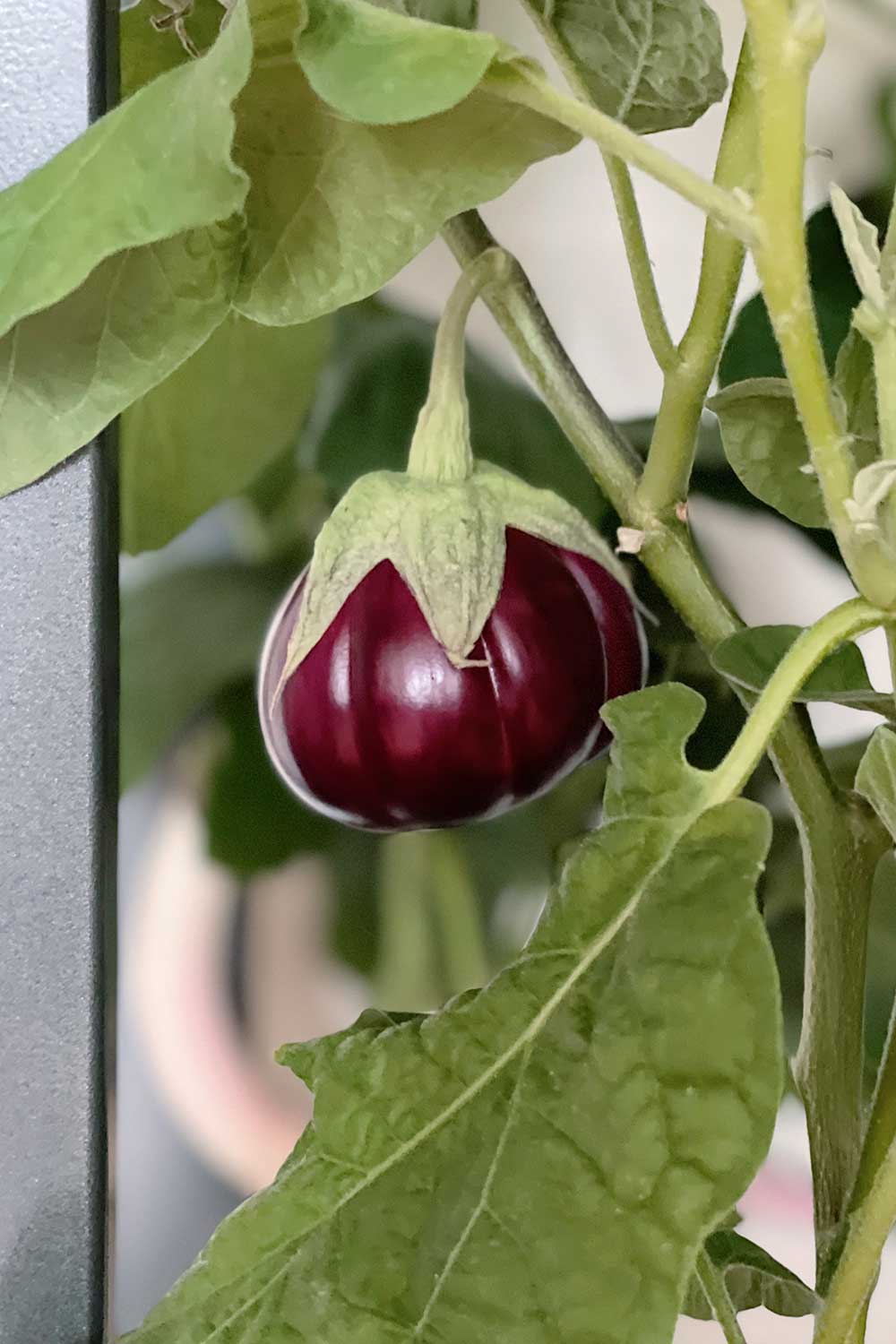
Thai eggplants like fertile, well draining soil and full sun.
Start seeds indoors 8-12 weeks before the last frost date.
A heat map helps to warm soil and speed up germination.
Eggplants really prefer warm soil and are quick producers, so transplant late rather than early.
This will reduce pressure from pests and also help produce stronger plants.
Sow around 18″ apart. Thai eggplants produce fruit around 65-75 days after transplant!
Some Thai eggplant varieties will require staking.
Make sure to harvest fruit regularly to promote new flowers and continuous fruit production.
Thai Eggplant Grow Guide
| Botanical Name | Solanum melongena |
| Common Name | Thai eggplant, |
| Mature Size | 2-3 inches tall |
| Days to Harvest | 75 days from seed |
| Light | Full sun |
| Soil Type | Rich, well draining soil |
| Soil pH | Neutral (6.2 – 6.8) |
| Hardiness Zones | USA Zones 2-10 |
| Native Area | Asia |
| Pests | aphids, flea beetles, caterpillars, spider mites |
| Diseases | blight, mosaic varieties, fungal diseases, powdery mildew |
Growing Hydroponic Thai Eggplants Indoors
I grow everything indoors inside my small NYC apartment so I’m always searching for compact vegetable varieties.
Thai eggplants are just about the max size and can be grown indoors in a smart garden with a bit of pruning and maintenance.
I grew mine in my Aerogarden Farm 12xl, which has a vertical height capacity of 3 feet.
If you’re looking to grow any kind of Asian eggplant or non-dwarf eggplant variety, I really recommend the Farm!
It has strong 60W LEDs with a full spectrum of red, white and blue lights that are necessary for fruit production.
growing Thai eggplants in a smart garden is very hands off + easy – try the Farm XL which has a 3 ft grow height capacity
I started seeds directly in the Farm and used the Grow Anything kit which has empty pods, sponges and labels.
Eggplants prefer warm temperatures and I started these in late spring but could tell that they absolutely thrived once the temperatures warmed up!
Since I was growing indoors, I didn’t have to worry about pests or weather conditions. Thai eggplants can be grown year round if you’re using a smart garden.
Best Indoor Gardening Products to Grow Eggplants
Indoor Gardens
Use Your Own Seeds
Aerogarden Discount Code
Use SSG15 for 15% off any order of $50+
How to Grow Thai Eggplants
A video grow guide covering everything you need to know about Thai eggplants, from seed to harvest!
How Long Does It Take to Grow Thai Eggplants?
On average, Thai eggplants take about 70 – 80 days to mature from transplanting, depending on the variety.
I started my seeds in early July, and grew them entirely from start to finish in my indoor hydroponic garden, the Aerogarden Farm 12xl.
In about 2 months time, I started seeing mini purple eggplants.
The fruit is plump and squat, with a slight oblong shape – like a mini pumpkin.
Troubleshooting: Thai Eggplant Flowers Keep Dropping
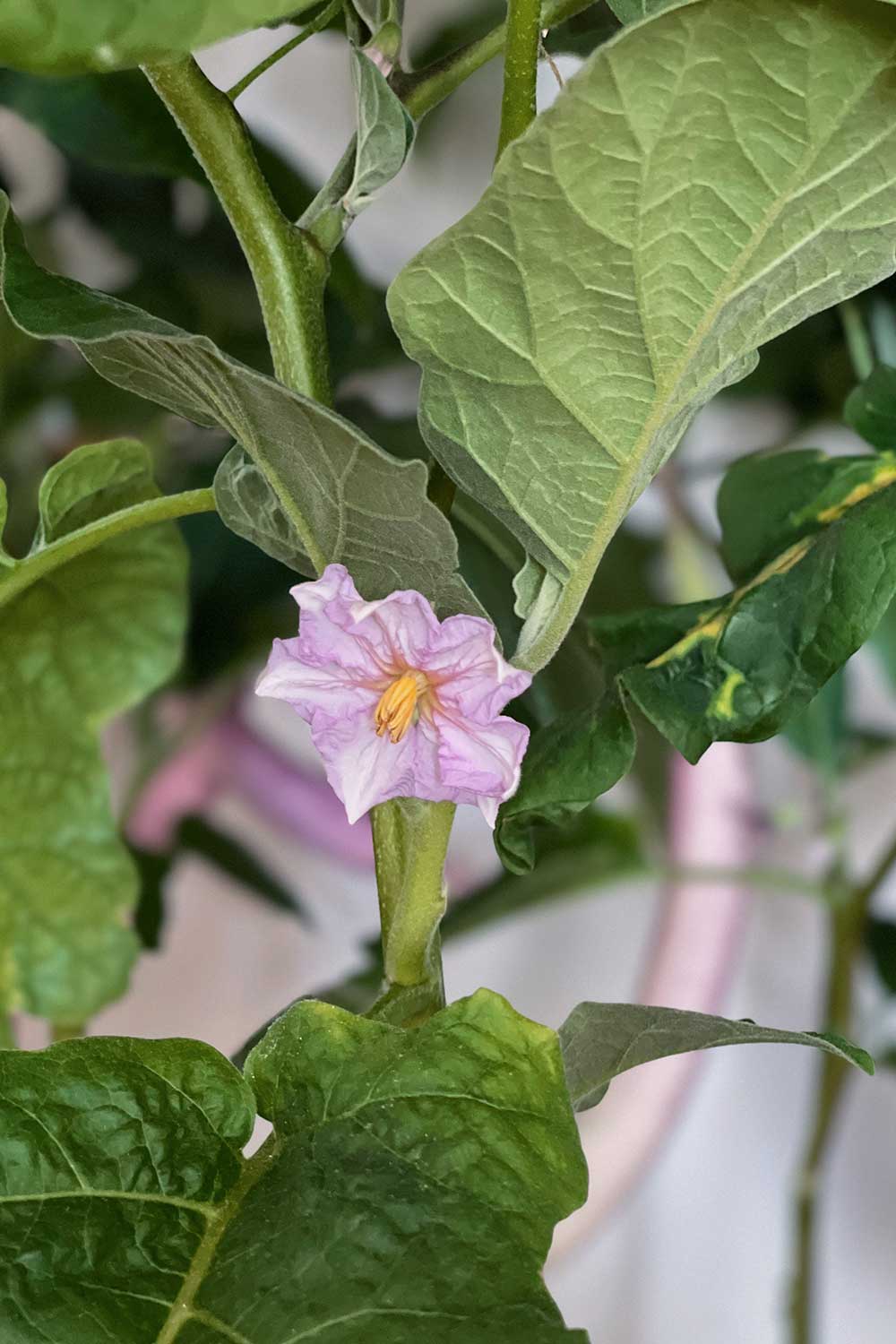
The only difficulty was with pollination. Thai eggplant flowers can be quite finicky.
I found that I needed to hand pollinate frequently and the Thai ribbed variety in particular needed a bit more hand holding.
If your Thai eggplant flowers keep dropping, you can try a tool like this one.
The electric tool bristles and vibrates to mimic the job that bees do and more evenly distributes pollen within each blossom.
But eventually, after a lot of patience and consistent pollination, I started to see the first ribbed Thai eggplants!
Do Thai Eggplants Need a Trellis?
From my experience, Thai eggplants are sturdy, compact plants. I didn’t need to trellis mine!
How Do You Know When Thai Eggplants Are Ripe?
Thai eggplants will start the color of the finished fruit. So, if you’re growing purple ribbed eggplants, the baby fruit will already be purple.
Likewise, white or green eggplants will stay white or green.
Don’t wait for a color change!
I originally thought some white eggplants with pale lavender skins would turn deep purple.
But they stayed white and eventually turned yellow once they got overripe.
Instead, focus on the skin.
Eggplants at their peak ripeness will have a glossy, vibrant color to the skin. As the fruit gets mature, the skin turns darker and more matte.
thai eggplants – purple (or white) from start to finish. no color change
How to Harvest Thai Eggplants
Harvest Thai eggplants when the skin looks shiny and glossy and the flesh is plump, with a slight give.
Don’t wait too long to harvest!
The fruit is quite small, about the size of a mini pumpkin.
But, small eggplants tend to have thinner skin and more tender flesh, so I think they taste better.
Once the fruit reaches maturity, the inside flesh will have lots of seeds and start to develop a bitter taste.
Meanwhile, the outside skin will change from a very glossy, vibrant purple to a deeper, matte purple.
If it starts turning dull and matte, you’ve waited too long.
To harvest, I recommend using kitchen shears. The plant stem is pretty firmly attached to the plant, so yanking it will often cause damage to the whole plant.
Some eggplant varieties have little prickly thorns at the base of the eggplant. The thorns are tiny so you might not see them, but they’ll hurt if you just stick your hands in and pull!
It’s much better to cut.
harvesting thai eggplants!
more hydroponics + recipes on tiktok @shershegrows
How to Store Thai Eggplants
It’s best to eat eggplants within 1 to 2 days of harvest. If you do that, you can keep them on your kitchen counter.
Otherwise, you should definitely store them in the fridge, in the crisper drawer.
Place the eggplants in a plastic bag to keep them as fresh as possible and use them within 1 week.
How Long Do Thai Eggplants Last in the Fridge
Thai eggplants should last for 5 to 7 days in the fridge.
But, ideally you should eat them as soon as possible for the best flavor and least amount of bitterness.
What’s the Difference Between Eggplant and Thai Eggplant?
Thai eggplants are much smaller than American eggplants.
They’re tiny, tangerine sized fruits and inside, they have less seeds than American eggplants.
Because they’re smaller and more tender, Thai eggplants taste less bitter than American eggplants.
They can also be eaten raw, which you’d never do with an American eggplant!
Do You Need to Peel Thai Eggplant?
Generally, Asian eggplants have thin skins so there’s no need to peel them.
You can salt them and soak them in a bowl of water if you’re worried about bitterness, but it’s really not needed!
Simply slice and cook.
I like to lightly coat them in potato starch or tempura and deep fry. They’re perfectly crunchy on the outside and creamy on the inside.
Read more: Chinese Eggplants in Garlic Sauce RecipeHow to Cook Thai Eggplant
Thai eggplants are typically small and round.
They look much different from the huge, chunky eggplants you typically find at the grocery store, like American Black Beauty!
Because Thai eggplants have thinner skin and fewer, smaller seeds, they’re very easy to cook.
There’s no need to peel them – just cut into chunks and add to curries, soups and stir frys.
You can even eat them raw, to add crunch to salads!
What Does Thai Eggplant Taste Like?
Thai eggplants are mild – in between the sweetness of a Japanese or Chinese eggplant but much less bitter than American eggplants.
They have firm flesh that can hold up well to Thai spices and curries, as well as deep frying in tempura.
Thai eggplants are usually added to dishes for texture.
I find that these taste best in curries. But I also like to lightly fry in tempura batter, or thickly slice and use in eggplant parm.
In Thailand, they’re also eaten pickled and raw, in salads.
These mini ribbed eggplants hold up well to lots of different cooking methods!
thai eggplants in various stages of maturity
Thai Ribbed Eggplant Recipes
Follow me on
